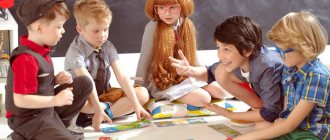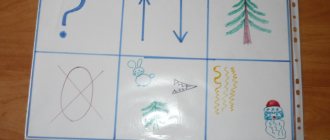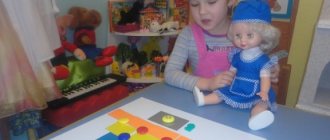Visual modeling technology in the correction of general speech underdevelopment of preschool children
Bibliographic description:
Pilipenko, T.V. Technology of visual modeling in the correction of general speech underdevelopment of preschool children / T.V. Pilipenko. — Text: direct // Education and upbringing. — 2022. — No. 1 (16). — P. 22-25. — URL: https://moluch.ru/th/4/archive/81/3074/ (access date: 02/05/2022).
Preschool education is the first stage in the education system, therefore the main task of teachers working with children with general speech underdevelopment is to create interest in the learning process and its motivation, development and correction of speech. Today it is absolutely possible to identify the emerging contradictions between the normative content of education common to all pupils and the individual capabilities of children. Children of senior preschool age with various speech disorders experience significant difficulties in mastering both the kindergarten curriculum and the curriculum in a comprehensive school. Learning difficulties are especially typical for children with general speech underdevelopment.
Working with children with various speech pathologies and facing problems in their learning, the speech therapist has to look for auxiliary means that facilitate, systematize and guide the process of children’s learning new material. One of these tools is visual modeling. What is visual modeling?
Visual modeling is the reproduction of the essential properties of the object being studied, the creation of its substitute and work with it.
The visual modeling method helps the child visually imagine abstract concepts (sound, word, sentence, text) and learn to work with them. This is especially important for preschoolers, since their mental problems are solved with the predominant role of external means; visual material is absorbed better than verbal material.
The preschooler is deprived of the opportunity to write down, make a table, or mark anything. In kindergarten classes, only one type of memory is mainly involved - verbal. Supporting schemes are an attempt to use visual, motor, and associative memory to solve cognitive problems.
Scientific research and practice confirm that visual models are the form of highlighting and designating relationships that is accessible to preschool children (Leon Lorenzo S., Khalizeva L. M., etc.). Scientists also note that the use of substitutes and visual models develops the mental abilities of preschoolers.
Consequently, using the visual modeling method in working with preschoolers allows us to solve the following problems:
‒ firstly, a preschool child is very flexible and easy to teach, but children with general speech underdevelopment are characterized by rapid fatigue and loss of interest in activities. Using visual modeling creates interest and helps solve this problem;
‒ secondly, the use of symbolic analogy facilitates and speeds up the process of memorizing and assimilating material, and forms techniques for working with memory. After all, one of the rules for strengthening memory says: “When you teach, write down, draw diagrams, diagrams, draw graphs”;
‒ thirdly, using a graphic analogy, we teach children to see the main thing and systematize the acquired knowledge.
Modeling consists of the following stages:
- assimilation and analysis of sensory material;
‒ translating it into sign-symbolic language;
- work with the model.
The formation of visual modeling skills occurs in a certain sequence with a constant increase in the proportion of independent participation of preschoolers. When developing visual modeling skills, the following didactic tasks are solved:
‒ familiarity with the graphical method of presenting information;
- development of the ability to decipher the model;
‒ developing the skill of independent modeling.
In speech therapy work, modeling acts as a specific method of cognition, on the one hand, and, on the other, as a program for analyzing new phenomena.
When preparing children for learning to read and write, the visual modeling method allows you to solve the following problems:
‒ intonationally highlight the sound in a word
‒ name words with a given sound
- find the position of a sound in a word and correlate it with the diagram
- depict vowel and consonant sounds using visual symbols.
When working with children, Tkachenko T. A.’s manual “Sounds and Signs” is successfully used to develop skills in sound analysis and synthesis.
Symbols of vowel sounds are indicated by geometric shapes familiar to children, corresponding to the position of the lips when articulating vowel sounds. To indicate consonant sounds, a visual image of an object or object capable of producing the corresponding sound is used. Children gradually become familiar with visual symbols as they learn vowels and consonants.
With the help of visual symbolism, children learn to analyze and synthesize the sound composition of a word. Merging sounds with the help of symbols is a simulation of reading, and composing words is an analogue of writing. But both happen in a lightweight, entertaining, playful version. Visual symbols improve the perception of speech sounds, contribute to the normalization of sound pronunciation, provide stable skills in sound analysis and synthesis, increase readiness for reading and writing, and train the child’s memory and attention.
When teaching literacy, a wide variety of games are used: “Spread pictures in the house”, “Where is the sound?”, “Traffic light”, “Where did the butterfly fly?”, etc.
In these games, children learn to identify the first and last sounds in words and relate them to the diagram; determine and mark the position of a given sound in a word; divide words into syllables. Modeling allows children to figuratively imagine the structure of a word, using substitutes for the syllables of which it consists, learn to determine the number of syllables, and relate the word to the syllable pattern. Children are prepared to develop the skill of syllable reading.
To form the syllabic structure of a word , the following games and exercises using models are successfully used: “Drawing Words”, “Pyramid”, “Houses”, etc.
Also, the visual modeling method helps improve lexical and grammatical categories . To do this, the following games and exercises are carried out using diagrams and models: “Clearing of related words”, “Choose the right picture”, “What is the word?”, “What is the preposition?” etc. In these games, children develop word formation and inflection skills, preschoolers learn to select related words based on conventional notation; They clarify spatial relationships expressed by prepositions, learn to compose sentences with them, and correctly use prepositions in speech.
When teaching coherent speech, the visual modeling method is used to work on all types of coherent utterances:
- retelling;
- compiling stories based on a painting and a series of paintings;
- descriptive story;
- creative story;
Schemes for writing descriptive stories on topics:
"Wild Animals" "Toys"
At this stage, the visual modeling method contributes to:
‒ mastering the principle of substitution (the ability to designate characters and attributes of a work of art with substitutes), conveying an event with the help of substitutes;
‒ mastering the ability to identify fragments of a picture that are significant for the development of the plot, determine the relationship between them and combine them into one plot;
- developing the ability to create a special plan and develop it into a complete story with various details and events;
- learning to write descriptive stories.
Using the visual modeling method in correctional work allows children to learn:
- obtain information, conduct research, make comparisons, draw up a clear internal plan for mental actions and speech statements;
- formulate and express judgments, draw conclusions;
- has a positive effect on the development of non-speech processes: attention, memory, thinking.
Consequently, we can conclude that by analyzing new material and graphically designating it, the child (under the guidance of adults) learns independence, perseverance, and visual perception of the plan of his actions. His sense of interest and responsibility increases, he becomes satisfied with the results of his work, mental processes such as memory, attention, and thinking improve, which has a positive effect on the effectiveness of correctional work.
The use of visual modeling in the system of correctional work gives a positive result, which is confirmed by diagnostic data on the level of speech development of children.
Thus, from all of the above, we can conclude: the visual modeling method can and should be used in the system of both correctional work with children of preschool and primary school age, and in work with children of mass groups of kindergarten and primary school.
Literature:
- Vorobyova V.K. Methodology for the development of coherent speech in children with systemic speech underdevelopment. -M., 2005
- Glukhov V.P. Formation of coherent speech in preschool children with general speech underdevelopment. - M., 2004
- Davydova T. G. Vvoznaya V. M. The use of support schemes in working with children. // Directory of senior preschool teacher 2008 No. 1
- Kudrova T.I. Modeling in teaching literacy to preschoolers with speech underdevelopment. // Speech therapist in kindergarten 2007 No. 4 p.51 -54
- Overcoming general speech underdevelopment in preschool children. / Ed. T.V. Volosovets. - M., 2007
- Rastorgueva N. I. Using pictograms to develop word formation skills in children with general speech underdevelopment. // Speech therapist 2002 No. 2 p.50–53
- Smyshlyaeva T. N. Korchuganova E. Yu. Using the method of visual modeling in the correction of general speech underdevelopment of preschool children. // Speech therapist 2005 No. 1 p. 7–12
- Tkachenko T. A. If a preschooler speaks poorly - St. Petersburg, 1997
- Tkachenko T. A. In first grade without speech defects - St. Petersburg, 1999.
Key terms
(automatically generated)
: visual modeling, child, word, kindergarten, correctional work, general speech underdevelopment, given sound, sound analysis, skill formation, skill formation.
MAGAZINE Preschooler.RF
Visual modeling as an effective means of mental development of preschool children- Kharchenko Anna Vladimirovna, Teacher of the Irkutsk Municipal Budgetary Educational Institution, Kindergarten No. 75;
- Shatokhina Marina Gennadievna, Teacher of the Irkutsk Municipal Budgetary Educational Institution, Kindergarten No. 75
The modern world is changing very quickly. Everything changes along with it, including thinking. The task of today's students is not simply to acquire knowledge, but to be able to obtain it independently and operate with it. Therefore, modern pedagogy is looking for opportunities to use the hidden reserves of children’s mental activity, ways of the most effective learning. The learning process, of course, should be as visual and as dynamic as possible. It should be noted that one of these ways to develop children's interest in learning is modeling.
Modeling is a visual and practical teaching method. A model is a generalized image of the significant properties of the object being modeled (room plan, geographic map, globe, etc.). The modeling method was developed by D. B. Elkonin, L. A. Wenger, N. A. Vetlugina, N. N. Poddyakov. Its essence lies in the development of a child’s thinking with the help of special schemes, models, which in a visual and accessible form reproduce the hidden properties and connections of a particular object.
In preschool pedagogy, there are three types of models:
- Subject model. This can be a physical structure, an object or objects that are naturally connected with each other. The model is an analogue of the object and reproduces its main connections and features.
- Subject-schematic model. In this case, essential components and connections between them are indicated using substitute objects and graphic signs. This model shows connections in a generalized form.
- Graphic model. Generally conveys different types of relationships, represents a graph, diagram, map, etc.
Visual modeling techniques include: substituents, pictograms, mnemonic tables.
In substitution, some objects are replaced by others. As a rule, paper squares, circles, ovals, different in color and size, are used as substitutes, since the substitution is based on some difference.
A pictogram is a symbolic image that replaces a word. This modeling technique refers to non-verbal means of communication and can be used in the following cases:
- when the child does not yet speak, but will soon master speech;
- for constant communication with a child who is unable to speak at all;
- to facilitate speech development;
- as preparation for mastering writing and reading;
- as a means of helping to express thoughts orally.
Mnemonic tables are diagrams that contain some information. The essence of the mnemonic diagram is this: for each word or small phrase you need to come up with some kind of picture; thus, the entire text is sketched schematically. The child will remember information much faster by looking at these diagrams and drawings. Therefore, we can say that mnemonic diagrams are a kind of memorization tool.
Many researchers believe that the modeling method can be used in various types of children's activities (N. N. Kondratyeva, M. V. Krulekht, A. K. Matveeva, T. D. Richterman, O. N. Somkova, etc.).
Indeed, modeling can be used everywhere - in mathematical and speech development, when familiarizing with fiction, in visual arts and when getting to know the world around us. The teacher is always looking for new ways and techniques that help make it easier for children to learn new material. Visual modeling is an excellent teacher’s assistant. It develops cognitive interest, teaches children to highlight the main idea, systematize their knowledge, and also helps prevent fatigue.
Using the visual modeling method in preschool education is very effective. After all, children understand various schematic images easily and quickly and use them successfully in the future. Older preschoolers only need one explanation to understand what a floor plan is, and they will freely find an object hidden in the room, focusing on the marks on the plan. Children easily recognize schematic representations of objects, use a map-type diagram to choose the right path in an extensive system of paths, etc.
It is known that it is easier for a child to learn many types of knowledge in the form of actions with models, rather than on the basis of a verbal explanation from an adult. For example, when forming mathematical concepts, it is extremely difficult for children to become familiar with the relationships between the part and the whole. Verbal methods in this case are not as effective as schematic images: when using visual modeling, children easily understand that a whole object can be divided and restored from parts.
What goals should a teacher pursue when using visual modeling in his work? First of all, develop cognitive interest, teach children to independently obtain information. The visual modeling method allows preschoolers to conduct research, make comparisons, and draw conclusions.
Practice shows that the use of modeling helps children easily navigate the sign system and coding methods, improves oral speech, promotes the development of logical and figurative thinking, memory, and attention. It also forms ideas about the world around us, work, etc.
Thus, we can say that modeling is one of the most effective methods of mental education of preschool children, since their thinking is characterized by objective imagery and visual concreteness. Therefore, it is possible and necessary to use the modeling method in the practice of preschool education. Teachers should not be afraid to use this technique, as it produces tangible results.
| Next > |







